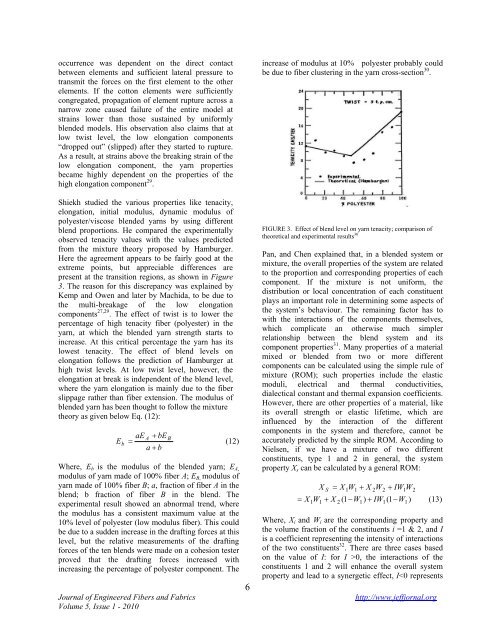Tensile Behaviour of Spun Yarns under Static State - Journal of ...
Tensile Behaviour of Spun Yarns under Static State - Journal of ...
Tensile Behaviour of Spun Yarns under Static State - Journal of ...
Create successful ePaper yourself
Turn your PDF publications into a flip-book with our unique Google optimized e-Paper software.
occurrence was dependent on the direct contact<br />
between elements and sufficient lateral pressure to<br />
transmit the forces on the first element to the other<br />
elements. If the cotton elements were sufficiently<br />
congregated, propagation <strong>of</strong> element rupture across a<br />
narrow zone caused failure <strong>of</strong> the entire model at<br />
strains lower than those sustained by uniformly<br />
blended models. His observation also claims that at<br />
low twist level, the low elongation components<br />
“dropped out” (slipped) after they started to rupture.<br />
As a result, at strains above the breaking strain <strong>of</strong> the<br />
low elongation component, the yarn properties<br />
became highly dependent on the properties <strong>of</strong> the<br />
high elongation component 29 .<br />
Shiekh studied the various properties like tenacity,<br />
elongation, initial modulus, dynamic modulus <strong>of</strong><br />
polyester/viscose blended yarns by using different<br />
blend proportions. He compared the experimentally<br />
observed tenacity values with the values predicted<br />
from the mixture theory proposed by Hamburger.<br />
Here the agreement appears to be fairly good at the<br />
extreme points, but appreciable differences are<br />
present at the transition regions, as shown in Figure<br />
3. The reason for this discrepancy was explained by<br />
Kemp and Owen and later by Machida, to be due to<br />
the multi-breakage <strong>of</strong> the low elongation<br />
components 27,29 . The effect <strong>of</strong> twist is to lower the<br />
percentage <strong>of</strong> high tenacity fiber (polyester) in the<br />
yarn, at which the blended yarn strength starts to<br />
increase. At this critical percentage the yarn has its<br />
lowest tenacity. The effect <strong>of</strong> blend levels on<br />
elongation follows the prediction <strong>of</strong> Hamburger at<br />
high twist levels. At low twist level, however, the<br />
elongation at break is independent <strong>of</strong> the blend level,<br />
where the yarn elongation is mainly due to the fiber<br />
slippage rather than fiber extension. The modulus <strong>of</strong><br />
blended yarn has been thought to follow the mixture<br />
theory as given below Eq. (12):<br />
E<br />
b<br />
aE A bEB<br />
(12)<br />
a b<br />
Where, E b is the modulus <strong>of</strong> the blended yarn; E A,<br />
modulus <strong>of</strong> yarn made <strong>of</strong> 100% fiber A; E B, modulus <strong>of</strong><br />
yarn made <strong>of</strong> 100% fiber B; a, fraction <strong>of</strong> fiber A in the<br />
blend; b fraction <strong>of</strong> fiber B in the blend. The<br />
experimental result showed an abnormal trend, where<br />
the modulus has a consistent maximum value at the<br />
10% level <strong>of</strong> polyester (low modulus fiber). This could<br />
be due to a sudden increase in the drafting forces at this<br />
level, but the relative measurements <strong>of</strong> the drafting<br />
forces <strong>of</strong> the ten blends were made on a cohesion tester<br />
proved that the drafting forces increased with<br />
increasing the percentage <strong>of</strong> polyester component. The<br />
<strong>Journal</strong> <strong>of</strong> Engineered Fibers and Fabrics<br />
Volume 5, Issue 1 - 2010<br />
6<br />
increase <strong>of</strong> modulus at 10% polyester probably could<br />
be due to fiber clustering in the yarn cross-section 30 .<br />
FIGURE 3. Effect <strong>of</strong> blend level on yarn tenacity; comparison <strong>of</strong><br />
theoretical and experimental results 30<br />
Pan, and Chen explained that, in a blended system or<br />
mixture, the overall properties <strong>of</strong> the system are related<br />
to the proportion and corresponding properties <strong>of</strong> each<br />
component. If the mixture is not uniform, the<br />
distribution or local concentration <strong>of</strong> each constituent<br />
plays an important role in determining some aspects <strong>of</strong><br />
the system’s behaviour. The remaining factor has to<br />
with the interactions <strong>of</strong> the components themselves,<br />
which complicate an otherwise much simpler<br />
relationship between the blend system and its<br />
component properties 31 . Many properties <strong>of</strong> a material<br />
mixed or blended from two or more different<br />
components can be calculated using the simple rule <strong>of</strong><br />
mixture (ROM); such properties include the elastic<br />
moduli, electrical and thermal conductivities,<br />
dialectical constant and thermal expansion coefficients.<br />
However, there are other properties <strong>of</strong> a material, like<br />
its overall strength or elastic lifetime, which are<br />
influenced by the interaction <strong>of</strong> the different<br />
components in the system and therefore, cannot be<br />
accurately predicted by the simple ROM. According to<br />
Nielsen, if we have a mixture <strong>of</strong> two different<br />
constituents, type 1 and 2 in general, the system<br />
property X s can be calculated by a general ROM:<br />
X S X 1W1<br />
X 2W2<br />
IW1W<br />
2<br />
1W1<br />
X 2 ( 1W1<br />
) IW1<br />
(1 W1<br />
)<br />
X<br />
(13)<br />
Where, X i and W i are the corresponding property and<br />
the volume fraction <strong>of</strong> the constituents i =1 & 2, and I<br />
is a coefficient representing the intensity <strong>of</strong> interactions<br />
<strong>of</strong> the two constituents 32 . There are three cases based<br />
on the value <strong>of</strong> I: for I >0, the interactions <strong>of</strong> the<br />
constituents 1 and 2 will enhance the overall system<br />
property and lead to a synergetic effect, I
















